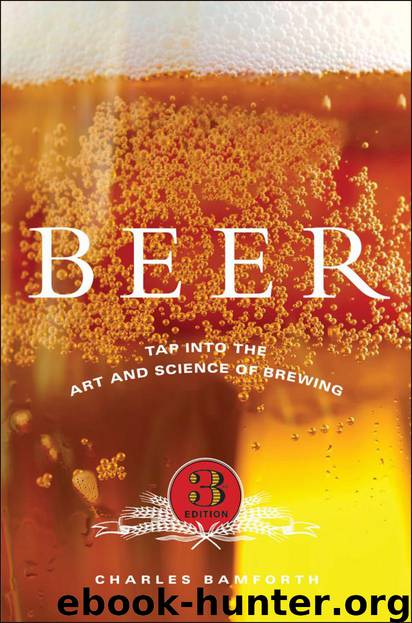Beer: Tap Into the Art and Science of Brewing by Charles Bamforth

Author:Charles Bamforth
Language: eng
Format: mobi
Tags: Science, Cooking, Organic, Chemistry, History
ISBN: 9780195305425
Publisher: Oxford University Press
Published: 2009-03-06T08:00:00+00:00
FIGURE 5.5 A modern germination vessel (courtesy of Stan Sole)
Germination in a pneumatic plant is generally at 16°C–20°C (61°F–68°F). In this process, some 4% of the dry weight of the grain is consumed to support the growth of embryonic tissues, and much heat is produced. To dissipate this heat demands the use of large amounts of attemperated air, whose oxygen is needed by the embryo for respiration, with the carbon dioxide produced being flushed away by the air flow.
Take a walk through a malting plant with an experienced maltster and you will see him grab a handful of germinating grain and spread it on the palm of one hand, glance at it, and then rub a few corns between the thumb and first finger. If the whole endosperm is readily squeezed out and if the shoot initials (the acrospire) are about three-quarters the length of the grain, then the “green malt” is ready for kilning.
KILNING
Kilning comprises the drying of malt to such a low level of moisture that it is stabilized, with germination arrested and enzymatic digestion halted. The enzymes of the malt, though, must not be destroyed: it is always important that the starch-degrading enzymes survive into malt, because the brewer needs those to generate fermentable sugars in the mash. Often it is important that the cell wall degrading enzymes survive, too, because they may not have completed their job in the malthouse—and they may be needed to deal with polysaccharides present in unmalted adjuncts that the Brewer may use in mashing.
There is a great variety of kiln designs, but most modern kilns feature deep beds of malt. They are most frequently circular in cross section and are likely to be made from corrosion-resistant steel. They have a source of heat for warming incoming air and a fan to drive or pull the air through the bed, together with the necessary loading and stripping systems. The grain is supported on a wedge-wire floor that permits air to pass through the bed, which is likely to be up to 1.2 meters (4 feet) deep.
Of course, kilning is an extremely energy-intensive operation, so modern kilns incorporate energy conservation systems such as glass tube air-to-air heat exchangers.
Newer kilns also use “indirect firing,” in which the products of fuel combustion don’t pass through the grain bed but are sent to exhaust, the air being warmed through a heater battery containing water as the conducting medium. Indirect firing arose because of concerns with the role of oxides of nitrogen present in kiln gases that might have promoted the formation of nitrosamines in malt. Nitrosamine levels have not been a problem in malt for many years.
Lower-temperature kilning regimes give malts of lighter color and tend to be employed in the production of malts destined for lager-style beers. Higher temperatures, apart from giving darker malts, also lead to a wholly different flavor spectrum. Lager malts give beers that are relatively rich in sulfur-containing compounds. Ale malts have more roasted, nutty characters. For both lager and ale
Download
This site does not store any files on its server. We only index and link to content provided by other sites. Please contact the content providers to delete copyright contents if any and email us, we'll remove relevant links or contents immediately.
| Culinary Biographies | Essays |
| Food Industry | History |
| Reference |
A Court of Wings and Ruin by Sarah J. Maas(7729)
The Death of the Heart by Elizabeth Bowen(3579)
The Sprouting Book by Ann Wigmore(3561)
Better Homes and Gardens New Cookbook by Better Homes & Gardens(3547)
BraveTart by Stella Parks(3416)
Salt, Fat, Acid, Heat: Mastering the Elements of Good Cooking by Nosrat Samin(3119)
Sauces by James Peterson(3071)
Kitchen confidential by Anthony Bourdain(3049)
The Bread Bible by Rose Levy Beranbaum(3036)
Classic by Mary Berry(2977)
Solo Food by Janneke Vreugdenhil(2946)
Ottolenghi - The Cookbook by Yotam Ottolenghi(2898)
Martha Stewart's Baking Handbook by Martha Stewart(2827)
Day by Elie Wiesel(2746)
Betty Crocker's Good and Easy Cook Book by Betty Crocker(2698)
The Plant Paradox by Dr. Steven R. Gundry M.D(2581)
My Pantry by Alice Waters(2578)
The Kitchen Counter Cooking School by Kathleen Flinn(2500)
Hot Sauce Nation by Denver Nicks(2466)
